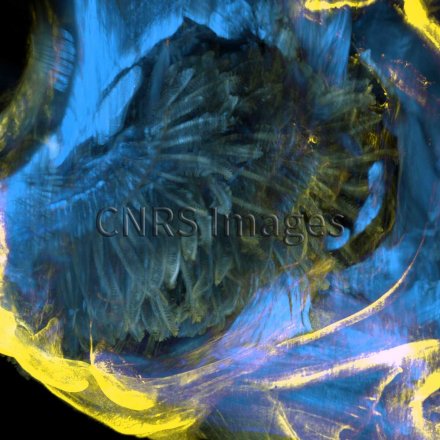Production year
2022

© Chloé EXBRAYAT-HERITIER / IGFL / CNRS Images
20220122_0005
In humans, Bethlem myopathy results from mutations in the gene encoding collagen VI, a component of the skeletal muscle extracellular matrix. This rare disease is characterised by muscle retractions and weakness, and a progressive worsening of symptoms, ranging from motor impairment to respiratory failure. The zebrafish is the only animal model that specifically reproduces one of the most common mutations found in patients. It is used to understand the functions of this collagen in the genesis and progression of the disease. This adult zebrafish head has been rendered transparent and labelled for collagen VI, in yellow. The combination of this labelling with the autofluorescence of the structures, in blue, reveals its gills, conjuring up the majestic plumage of the blue-and-yellow macaw. This image was taken using light sheet microscopy. It is one of the winners of the 2022 La preuve par l’image (LPPI) photography competition.
The use of media visible on the CNRS Images Platform can be granted on request. Any reproduction or representation is forbidden without prior authorization from CNRS Images (except for resources under Creative Commons license).
No modification of an image may be made without the prior consent of CNRS Images.
No use of an image for advertising purposes or distribution to a third party may be made without the prior agreement of CNRS Images.
For more information, please consult our general conditions
2022
Our work is guided by the way scientists question the world around them and we translate their research into images to help people to understand the world better and to awaken their curiosity and wonderment.